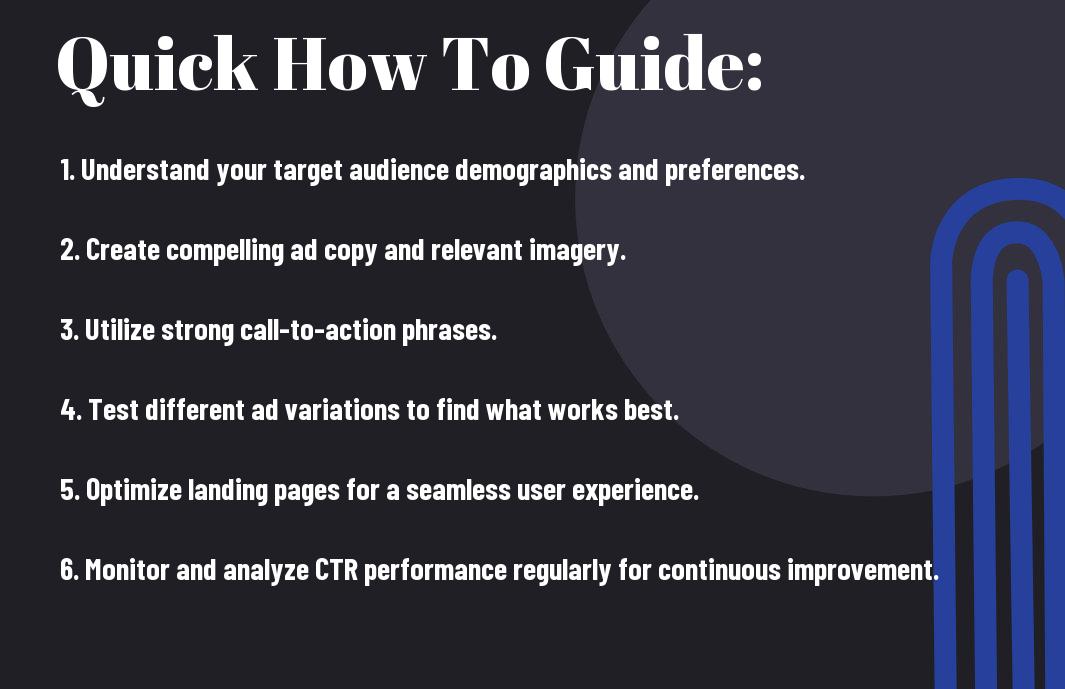5 Essential Tips for Effective CTR Optimization Success
Maximizing Click-Through Rate (CTR) is crucial for the success of any online marketing campaign. Your CTR directly impacts your website’s traffic and ultimately your conversion rates. To help you achieve optimal results, we’ve compiled five important tips for effective CTR optimization that you need to incorporate into your digital strategy.

Understanding Your Audience
All you need to know about CTR optimization starts with understanding your audience. Knowing who your target audience is and what they are looking for is necessary for optimizing click-through rates. By understanding your audience’s needs, preferences, and behaviors, you can tailor your content and campaigns to better resonate with them, ultimately leading to higher click-through rates and conversions.
Analyzing User Intent
Audience intent plays a crucial role in CTR optimization. By analyzing user intent, you can gain insights into what motivates your audience to click on a specific link or ad. Understanding whether users are looking for information, products, or simply browsing can help you craft more targeted and compelling messaging that resonates with their needs.
By using tools like Google Analytics and social media insights, you can track user behavior, preferences, and interactions to gain a deeper understanding of your audience’s intent. This data-driven approach can help you optimize your campaigns by aligning them with what your audience is actively searching for, leading to higher CTRs and engagement.
Creating Buyer Personas for Targeted Campaigns
One effective way to understand your audience better is by creating buyer personas. By segmenting your audience into specific personas based on demographics, interests, and behaviors, you can tailor your messaging to address their unique needs and pain points. This targeted approach allows you to create more personalized and relevant content that resonates with each segment of your audience, ultimately boosting your CTR and conversion rates.
Creating buyer personas involves conducting research, analyzing data, and interviewing existing customers to gather insights. By identifying common traits and characteristics among your audience segments, you can create detailed personas that represent your ideal customers. Using these personas as a guide, you can develop content and campaigns that speak directly to the needs and preferences of each group, increasing the effectiveness of your CTR optimization strategies.
Crafting Compelling Ad Copy
Any effective digital marketing strategy relies heavily on crafting compelling ad copy that grabs the attention of your target audience and drives them to take action. The ad copy is the first impression that potential customers will have of your brand, so it’s crucial to make it impactful and persuasive.
Key Elements of Effective Ad Text
Effective ad text should be clear, concise, and compelling. Start by identifying your unique selling proposition and highlighting it in your ad. Use strong language that creates a sense of urgency and encourages users to click. Incorporate relevant keywords to improve relevance and quality score, which can directly impact your click-through rate (CTR).
How to Use Emotional Triggers to Boost Engagement
Engagement with your ad can be significantly boosted by tapping into emotional triggers. Use emotive language that resonates with your audience on a personal level. Highlight the benefits of your product or service in a way that evokes emotions such as excitement, fear of missing out, or a sense of belonging. Emotional ad copy can create a connection with potential customers, making them more likely to engage with your ad.
A well-crafted ad that uses emotional triggers can have a powerful impact on your CTR and overall campaign performance. By appealing to the emotions of your audience, you can create a lasting impression that leads to higher engagement and conversion rates.
Designing Attention-Grabbing Ad Creatives
Once again, creating compelling ad creatives is crucial for maximizing your click-through rate (CTR) and driving conversions. As far as designing ad creatives that capture viewers’ attention and entice them to click, there are several key strategies to keep in mind.
Tips for Using Images and Videos to Increase CTR
With visual content playing a significant role in digital advertising, incorporating high-quality images and videos can significantly increase the effectiveness of your ads. Make sure to use relevant and eye-catching visuals that resonate with your target audience. Additionally, consider showcasing your products or services in action to give viewers a real sense of what to expect.
- Optimize images and videos for fast loading times
- Use compelling visuals that evoke emotion
- Include clear calls to action to guide viewers on the next steps
Though integrating images and videos can enhance your ad creatives, it’s imperative to strike a balance to ensure they complement your ad copy and overall message seamlessly.
Best Practices for Ad Formatting and Visual Hierarchy
On top of captivating visuals, the way you format your ads and establish visual hierarchy plays a critical role in attracting and retaining viewers’ attention. When designing ad creatives, pay close attention to the placement of your headline, description, images, and call-to-action button to create a clear and visually appealing layout that guides viewers through the ad.
Increase the legibility and comprehension of your ad by using contrasting colors for key elements and maintaining consistent branding throughout. Keeping your ad design simple and clutter-free can also help highlight your message and increase the likelihood of engagement from your audience.
Choosing the Right Keywords
Your 5 Essential Tips for Boosting Your Google Ads Performance start with selecting the right keywords. This is a crucial step in your CTR optimization strategy. By choosing the right keywords, you can attract the right audience and improve the relevance of your ads, leading to higher click-through rates.
Tools for Keyword Research
One of the primary steps in choosing the right keywords is conducting thorough research. Utilize online tools such as Google Keyword Planner, SEMrush, or Moz Keyword Explorer to identify relevant keywords that align with your business goals. These tools provide insights into search volume, competition level, and potential performance of specific keywords, aiding in your decision-making process. By leveraging these keyword research tools, you can uncover valuable insights that will guide your keyword selection for optimal CTR optimization.
How to Integrate Keywords into Your Ads Strategically
Any successful CTR optimization strategy involves strategically integrating keywords into your ads. Ensure that your chosen keywords are prominently featured in your ad copy, headlines, and display URLs. By incorporating relevant keywords in your ads, you increase the chances of attracting clicks from users searching for those specific terms. Additionally, consider creating ad groups based on keyword themes to further tailor your messaging and improve ad relevance.
Keywords play a vital role in driving the success of your CTR optimization efforts. Continuously monitor and refine your keyword selection to ensure that they remain relevant and effective. By strategically integrating keywords into your ads and regularly updating them based on performance data, you can enhance the effectiveness of your campaigns and drive higher click-through rates.
Landing Page Optimization
All successful digital marketing campaigns rely on effective landing page optimization to maximize conversions. A well-optimized landing page can make all the difference in turning visitors into customers. Here are some vital tips for optimizing your landing pages to boost your Click-Through Rates (CTR) and overall campaign performance.
How to Align Landing Pages with Ad Messaging
Landing pages should always be closely aligned with the ad messaging that drives traffic to them. When a visitor clicks on an ad, they have certain expectations based on the messaging they saw. Make sure your landing page delivers on those expectations seamlessly. The headline, images, and content on the landing page should all align with the ad that brought the visitor there, creating a continuity in messaging that builds trust and keeps the visitor engaged.
To further enhance this alignment, consider using dynamic text replacement on your landing pages. This technique allows you to personalize the content based on the keywords or ad copy that led the visitor to the page. By tailoring the messaging to match the visitor’s intent, you can significantly improve the chances of conversion.
Improving User Experience to Encourage Conversions
Optimization of user experience is key to encouraging visitors to take the desired action on your landing page. Factors such as page load speed, mobile responsiveness, and clear call-to-action buttons all play a crucial role in determining whether a visitor converts or bounces. Make sure your landing page is optimized for speed and is responsive across all devices to provide a seamless user experience.
To further encourage conversions, consider incorporating trust signals such as customer testimonials, security badges, and guarantees to reassure visitors and build credibility. By enhancing the user experience and addressing any potential concerns or objections, you can create a more positive environment for visitors to take action, ultimately improving your CTR and conversion rates.
Testing and Analyzing for Improvement
Many online advertisers understand the importance of continuously testing and analyzing their campaigns to achieve optimal results. By actively experimenting with different elements and analyzing data, advertisers can identify what works best for their target audience and make informed decisions to optimize their click-through rates (CTR).
A/B Testing Methods for Ads and Landing Pages
With A/B testing, advertisers create two versions of an ad or landing page with one key difference and show them to separate audiences. By comparing the performance of the two versions, advertisers can determine which element (such as a headline, image, or call-to-action) resonates better with their audience and drives higher CTR. It is crucial to track and analyze metrics like CTR, conversion rate, and bounce rate to draw meaningful conclusions from the test results.
Interpreting Data to Fine-Tune Your Strategy
Methods of interpreting data to fine-tune your strategy involve identifying patterns and trends in the collected data to make informed decisions. By analyzing metrics over time, advertisers can gain valuable insights into audience behavior and preferences, allowing them to adjust their strategies accordingly. Understanding the data and making data-driven decisions is crucial for continuous improvement in CTR optimization.
Interpreting data to fine-tune your strategy is an ongoing process that requires attention to detail and a willingness to iterate on your campaigns based on the insights gained. By leveraging data analysis tools and techniques, advertisers can unlock valuable insights that lead to improved CTR performance and overall campaign success.
Adapting to Platform-Specific Factors
Not all CTR optimization strategies apply universally across different platforms. The key to achieving success lies in understanding and adapting to the platform-specific factors that influence user behavior and engagement.
- Recognize the unique user demographics and behaviors on each platform.
- Optimize ad formats and messaging to align with the platform’s user experience.
- Adjust bidding strategies based on platform auction dynamics.
- Utilize platform-specific targeting options to reach the right audience effectively.
Perceiving and leveraging these differences will enable you to maximize your CTR and drive better results with your advertising campaigns.
Adjusting for Mobile vs Desktop Users
Adapting your CTR optimization approach to cater to the distinctions between mobile and desktop users is vital for success. With the increasing dominance of mobile usage, ensuring that your ads are optimized for smaller screens and touch interactions is critical. Mobile users tend to have shorter attention spans and different browsing behaviors compared to desktop users, necessitating tailored ad creatives and placement strategies.
By analyzing how users interact with your ads on both mobile and desktop platforms, you can make informed decisions on adjustments to improve CTR performance across all devices.
Utilizing Platform Analytics for Enhanced CTR
Adapting your CTR optimization strategy to make the most of platform analytics can provide valuable insights for boosting engagement and conversions. By leveraging the data available on platforms like Google Ads, Facebook Ads Manager, or LinkedIn Analytics, you can pinpoint trends, identify opportunities, and optimize your campaigns for better CTR. Real-time performance metrics and audience insights can inform your decisions and lead to more effective targeting and messaging strategies.
For instance, tracking key performance indicators such as click-through rates, conversion rates, and audience demographics can reveal which aspects of your campaigns are resonating with users and which areas need improvement.

Final Words
The five necessary tips for effective CTR optimization success are crucial for digital marketers looking to improve the performance of their online campaigns. By following these guidelines, you can increase your click-through rates, drive more traffic to your website, and ultimately achieve your marketing goals. Remember to continuously analyze your data, be strategic with your targeting, test different elements, optimize for mobile, and focus on creating compelling ad copy. By implementing these best practices, you can set yourself up for success in the competitive world of online advertising.
Are the Essential Tips for CTR Optimization also applicable for CTR Manipulation?
Yes, the essential tips for CTR optimization can also be applied for the art of CTR manipulation. However, the difference lies in the intent behind the actions. While CTR optimization focuses on improving user experience and relevance, CTR manipulation is aimed at misleading algorithms for artificial gains.
FAQ
Q: What is CTR Optimization?
A: CTR Optimization stands for Click-Through Rate Optimization. It is the process of improving the percentage of users who click on a specific link to the total number of users who view a page, email, or advertisement.
Q: Why is CTR Optimization Important?
A: CTR Optimization is crucial because it helps increase traffic to your website, improve conversion rates, and ultimately boost your revenue and return on investment (ROI).
Q: How can I Improve CTR for my online ads?
A: You can improve CTR for your online ads by using compelling ad copy, relevant keywords, eye-catching visuals, and by testing different variations to see what works best.
Q: What are the benefits of effective CTR Optimization?
A: The benefits of effective CTR Optimization include higher visibility in search engine results, increased website traffic, improved user engagement, and higher conversion rates.
Q: What are the key metrics to monitor for CTR Optimization success?
A: The key metrics to monitor for CTR Optimization success include click-through rate, conversion rate, bounce rate, average session duration, and return on ad spend (ROAS).
Q: How often should I review and adjust my CTR Optimization strategy?
A: It is recommended to review and adjust your CTR Optimization strategy regularly, at least once a month, to stay up-to-date with changes in user behavior, industry trends, and algorithm updates.
Q: What are common mistakes to avoid in CTR Optimization?
A: Common mistakes to avoid in CTR Optimization include using clickbait tactics, misleading or irrelevant ad copy, neglecting mobile optimization, ignoring A/B testing, and failing to analyze performance data to make informed decisions.</pCTR optimizationing Click-Through Rate (CTR) is crucial for the success of any online marketing campaign. Your CTR directly impacts your website’s traffic and ultimately your conversion rates. To help you achieve optimal results, we’ve compiled five important tips for effective CTR optimization that you need to incorporate into your digital strategy.

Understanding Your Audience
All you need to know about CTR optimization starts with understanding your audience. Knowing who your target audience is and what they are looking for is necessary for optimizing click-through rates. By understanding your audience’s needs, preferences, and behaviors, you can tailor your content and campaigns to better resonate with them, ultimately leading to higher click-through rates and conversions.
Analyzing User Intent
Audience intent plays a crucial role in CTR optimization. By analyzing user intent, you can gain insights into what motivates your audience to click on a specific link or ad. Understanding whether users are looking for information, products, or simply browsing can help you craft more targeted and compelling messaging that resonates with their needs.
By using tools like Google Analytics and social media insights, you can track user behavior, preferences, and interactions to gain a deeper understanding of your audience’s intent. This data-driven approach can help you optimize your campaigns by aligning them with what your audience is actively searching for, leading to higher CTRs and engagement.
Creating Buyer Personas for Targeted Campaigns
One effective way to understand your audience better is by creating buyer personas. By segmenting your audience into specific personas based on demographics, interests, and behaviors, you can tailor your messaging to address their unique needs and pain points. This targeted approach allows you to create more personalized and relevant content that resonates with each segment of your audience, ultimately boosting your CTR and conversion rates.
Creating buyer personas involves conducting research, analyzing data, and interviewing existing customers to gather insights. By identifying common traits and characteristics among your audience segments, you can create detailed personas that represent your ideal customers. Using these personas as a guide, you can develop content and campaigns that speak directly to the needs and preferences of each group, increasing the effectiveness of your CTR optimization strategies.
Crafting Compelling Ad Copy
Any effective digital marketing strategy relies heavily on crafting compelling ad copy that grabs the attention of your target audience and drives them to take action. The ad copy is the first impression that potential customers will have of your brand, so it’s crucial to make it impactful and persuasive.
Key Elements of Effective Ad Text
Effective ad text should be clear, concise, and compelling. Start by identifying your unique selling proposition and highlighting it in your ad. Use strong language that creates a sense of urgency and encourages users to click. Incorporate relevant keywords to improve relevance and quality score, which can directly impact your click-through rate (CTR).
How to Use Emotional Triggers to Boost Engagement
Engagement with your ad can be significantly boosted by tapping into emotional triggers. Use emotive language that resonates with your audience on a personal level. Highlight the benefits of your product or service in a way that evokes emotions such as excitement, fear of missing out, or a sense of belonging. Emotional ad copy can create a connection with potential customers, making them more likely to engage with your ad.
A well-crafted ad that uses emotional triggers can have a powerful impact on your CTR and overall campaign performance. By appealing to the emotions of your audience, you can create a lasting impression that leads to higher engagement and conversion rates.
Designing Attention-Grabbing Ad Creatives
Once again, creating compelling ad creatives is crucial for maximizing your click-through rate (CTR) and driving conversions. As far as designing ad creatives that capture viewers’ attention and entice them to click, there are several key strategies to keep in mind.
Tips for Using Images and Videos to Increase CTR
With visual content playing a significant role in digital advertising, incorporating high-quality images and videos can significantly increase the effectiveness of your ads. Make sure to use relevant and eye-catching visuals that resonate with your target audience. Additionally, consider showcasing your products or services in action to give viewers a real sense of what to expect.
- Optimize images and videos for fast loading times
- Use compelling visuals that evoke emotion
- Include clear calls to action to guide viewers on the next steps
Though integrating images and videos can enhance your ad creatives, it’s imperative to strike a balance to ensure they complement your ad copy and overall message seamlessly.
Best Practices for Ad Formatting and Visual Hierarchy
On top of captivating visuals, the way you format your ads and establish visual hierarchy plays a critical role in attracting and retaining viewers’ attention. When designing ad creatives, pay close attention to the placement of your headline, description, images, and call-to-action button to create a clear and visually appealing layout that guides viewers through the ad.
Increase the legibility and comprehension of your ad by using contrasting colors for key elements and maintaining consistent branding throughout. Keeping your ad design simple and clutter-free can also help highlight your message and increase the likelihood of engagement from your audience.
Choosing the Right Keywords
Your 5 Essential Tips for Boosting Your Google Ads Performance start with selecting the right keywords. This is a crucial step in your CTR optimization strategy. By choosing the right keywords, you can attract the right audience and improve the relevance of your ads, leading to higher click-through rates.
Tools for Keyword Research
One of the primary steps in choosing the right keywords is conducting thorough research. Utilize online tools such as Google Keyword Planner, SEMrush, or Moz Keyword Explorer to identify relevant keywords that align with your business goals. These tools provide insights into search volume, competition level, and potential performance of specific keywords, aiding in your decision-making process. By leveraging these keyword research tools, you can uncover valuable insights that will guide your keyword selection for optimal CTR optimization.
How to Integrate Keywords into Your Ads Strategically
Any successful CTR optimization strategy involves strategically integrating keywords into your ads. Ensure that your chosen keywords are prominently featured in your ad copy, headlines, and display URLs. By incorporating relevant keywords in your ads, you increase the chances of attracting clicks from users searching for those specific terms. Additionally, consider creating ad groups based on keyword themes to further tailor your messaging and improve ad relevance.
Keywords play a vital role in driving the success of your CTR optimization efforts. Continuously monitor and refine your keyword selection to ensure that they remain relevant and effective. By strategically integrating keywords into your ads and regularly updating them based on performance data, you can enhance the effectiveness of your campaigns and drive higher click-through rates.
Landing Page Optimization
All successful digital marketing campaigns rely on effective landing page optimization to maximize conversions. A well-optimized landing page can make all the difference in turning visitors into customers. Here are some vital tips for optimizing your landing pages to boost your Click-Through Rates (CTR) and overall campaign performance.
How to Align Landing Pages with Ad Messaging
Landing pages should always be closely aligned with the ad messaging that drives traffic to them. When a visitor clicks on an ad, they have certain expectations based on the messaging they saw. Make sure your landing page delivers on those expectations seamlessly. The headline, images, and content on the landing page should all align with the ad that brought the visitor there, creating a continuity in messaging that builds trust and keeps the visitor engaged.
To further enhance this alignment, consider using dynamic text replacement on your landing pages. This technique allows you to personalize the content based on the keywords or ad copy that led the visitor to the page. By tailoring the messaging to match the visitor’s intent, you can significantly improve the chances of conversion.
Improving User Experience to Encourage Conversions
Optimization of user experience is key to encouraging visitors to take the desired action on your landing page. Factors such as page load speed, mobile responsiveness, and clear call-to-action buttons all play a crucial role in determining whether a visitor converts or bounces. Make sure your landing page is optimized for speed and is responsive across all devices to provide a seamless user experience.
To further encourage conversions, consider incorporating trust signals such as customer testimonials, security badges, and guarantees to reassure visitors and build credibility. By enhancing the user experience and addressing any potential concerns or objections, you can create a more positive environment for visitors to take action, ultimately improving your CTR and conversion rates.
Testing and Analyzing for Improvement
Many online advertisers understand the importance of continuously testing and analyzing their campaigns to achieve optimal results. By actively experimenting with different elements and analyzing data, advertisers can identify what works best for their target audience and make informed decisions to optimize their click-through rates (CTR).
A/B Testing Methods for Ads and Landing Pages
With A/B testing, advertisers create two versions of an ad or landing page with one key difference and show them to separate audiences. By comparing the performance of the two versions, advertisers can determine which element (such as a headline, image, or call-to-action) resonates better with their audience and drives higher CTR. It is crucial to track and analyze metrics like CTR, conversion rate, and bounce rate to draw meaningful conclusions from the test results.
Interpreting Data to Fine-Tune Your Strategy
Methods of interpreting data to fine-tune your strategy involve identifying patterns and trends in the collected data to make informed decisions. By analyzing metrics over time, advertisers can gain valuable insights into audience behavior and preferences, allowing them to adjust their strategies accordingly. Understanding the data and making data-driven decisions is crucial for continuous improvement in CTR optimization.
Interpreting data to fine-tune your strategy is an ongoing process that requires attention to detail and a willingness to iterate on your campaigns based on the insights gained. By leveraging data analysis tools and techniques, advertisers can unlock valuable insights that lead to improved CTR performance and overall campaign success.
Adapting to Platform-Specific Factors
Not all CTR optimization strategies apply universally across different platforms. The key to achieving success lies in understanding and adapting to the platform-specific factors that influence user behavior and engagement.
- Recognize the unique user demographics and behaviors on each platform.
- Optimize ad formats and messaging to align with the platform’s user experience.
- Adjust bidding strategies based on platform auction dynamics.
- Utilize platform-specific targeting options to reach the right audience effectively.
Perceiving and leveraging these differences will enable you to maximize your CTR and drive better results with your advertising campaigns.
Adjusting for Mobile vs Desktop Users
Adapting your CTR optimization approach to cater to the distinctions between mobile and desktop users is vital for success. With the increasing dominance of mobile usage, ensuring that your ads are optimized for smaller screens and touch interactions is critical. Mobile users tend to have shorter attention spans and different browsing behaviors compared to desktop users, necessitating tailored ad creatives and placement strategies.
By analyzing how users interact with your ads on both mobile and desktop platforms, you can make informed decisions on adjustments to improve CTR performance across all devices.
Utilizing Platform Analytics for Enhanced CTR
Adapting your CTR optimization strategy to make the most of platform analytics can provide valuable insights for boosting engagement and conversions. By leveraging the data available on platforms like Google Ads, Facebook Ads Manager, or LinkedIn Analytics, you can pinpoint trends, identify opportunities, and optimize your campaigns for better CTR. Real-time performance metrics and audience insights can inform your decisions and lead to more effective targeting and messaging strategies.
For instance, tracking key performance indicators such as click-through rates, conversion rates, and audience demographics can reveal which aspects of your campaigns are resonating with users and which areas need improvement.

Final Words
The five necessary tips for effective CTR optimization success are crucial for digital marketers looking to improve the performance of their online campaigns. By following these guidelines, you can increase your click-through rates, drive more traffic to your website, and ultimately achieve your marketing goals. Remember to continuously analyze your data, be strategic with your targeting, test different elements, optimize for mobile, and focus on creating compelling ad copy. By implementing these best practices, you can set yourself up for success in the competitive world of online advertising.
FAQ
Q: What is CTR Optimization?
A: CTR Optimization stands for Click-Through Rate Optimization. It is the process of improving the percentage of users who click on a specific link to the total number of users who view a page, email, or advertisement.
Q: Why is CTR Optimization Important?
A: CTR Optimization is crucial because it helps increase traffic to your website, improve conversion rates, and ultimately boost your revenue and return on investment (ROI).
Q: How can I Improve CTR for my online ads?
A: You can improve CTR for your online ads by using compelling ad copy, relevant keywords, eye-catching visuals, and by testing different variations to see what works best.
Q: What are the benefits of effective CTR Optimization?
A: The benefits of effective CTR Optimization include higher visibility in search engine results, increased website traffic, improved user engagement, and higher conversion rates.
Q: What are the key metrics to monitor for CTR Optimization success?
A: The key metrics to monitor for CTR Optimization success include click-through rate, conversion rate, bounce rate, average session duration, and return on ad spend (ROAS).
Q: How often should I review and adjust my CTR Optimization strategy?
A: It is recommended to review and adjust your CTR Optimization strategy regularly, at least once a month, to stay up-to-date with changes in user behavior, industry trends, and algorithm updates.
Q: What are common mistakes to avoid in CTR Optimization?
A: Common mistakes to avoid in CTR Optimization include using clickbait tactics, misleading or irrelevant ad copy, neglecting mobile optimization, ignoring A/B testing, and failing to analyze performance data to make informed decisions.


